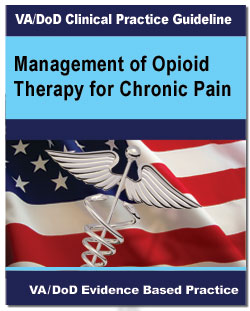Relationship Between Menopause, Chronic Pain Not Adequately Understood
By Annette M. Boyle

Carolyn Gibson, PhD, MPH
SAN FRANCISCO—The VA has focused on reducing the risk of opioid abuse and addiction by issuing guidance that strongly recommends against the use of the painkillers for chronic pain since the implementation of the Opioid Safety Initiative in 2013. While veterans with post-traumatic stress disorder, substance use disorder and obstructive sleep apnea are known to be at high risk, another group appears to face an even higher risk of inappropriate prescriptions for long-term opioid therapy for chronic pain—women veterans.
Researchers at the San Francisco VA Health Care System discovered that nearly 1 in 5 women veterans was prescribed opioid therapy for chronic pain for more than 90 days, and 1 in 9 were co-prescribed opioids and benzodiazepines or sleep aids. They presented their findings at the 2017 meeting of the North American Menopause Society.1
 “This is not consistent with current VA guidelines, released in early 2017, which recommend against the use of both long-term opioids for chronic pain and any concurrent use of opioids and sedative/hypnotics,” explained lead author Carolyn Gibson, PhD, MPH, of the San Francisco VA.
“This is not consistent with current VA guidelines, released in early 2017, which recommend against the use of both long-term opioids for chronic pain and any concurrent use of opioids and sedative/hypnotics,” explained lead author Carolyn Gibson, PhD, MPH, of the San Francisco VA.
The current guidelines recommend opioid use for chronic pain only for intermittent use for limited conditions and only after trying multiple other therapies. Self-management and optimized treatment of comorbidities should be the first-line therapy for chronic pain, followed by the addition of nonpharmacological therapies such as acupuncture. Use of pharmaceuticals of any kind is not recommended, unless the initial options fail to relieve pain and only after discussion with the patient about the limitations of pharmacotherapy. If simultaneous implementation of all these modalities does not relieve pain, the guidelines recommend referring veterans for intensive interdisciplinary pain rehabilitation. Opioid therapy may be considered on a short-term basis in this context.
Gibson noted that data for this study were drawn from 2014-2015, when the VA was escalating communications about the risks of opioid prescribing for chronic pain. “Additional research is needed to determine if prescribing rates for women veterans have declined since 2015, commensurate with increasing education efforts and the release of these new guidelines,” she told U.S. Medicine.
Risk of Chronic Pain Elevated
Women going through the menopause transition had the highest risk of experiencing chronic pain and being prescribed long-term opioid therapy. The study found that menopause-related diagnoses elevated a woman veteran’s risk of chronic pain by 85% and her risk of multiple diagnoses for chronic pain 78%. A menopause-related diagnosis also increased the likelihood of a long-term opioid prescription by 15% and concurrent opioid and sedative or hypnotic prescriptions by 18%, compared to women without such a diagnosis.
A poor understanding of the relationship between menopause and chronic pain might contribute to increased prescribing of opioids to women during this transition. “Understanding these issues should be paramount in the Veterans Affairs Health Care System, where chronic pain is a leading diagnosis, opioid use and misuse is a prevalent concern, and an estimated half of women veteran VA users are peri- or postmenopausal,” wrote Gibson and her colleagues.

Women veterans participating in observance of Veterans Day 2017 at Arlington National Cemetery. A new study says that older women veterans have higher rates of chronic pain. VA photos Robert Turtil
High-risk opioid use among women in midlife may be related to negative mood symptoms, mental health comorbidities and sleep issues common during the menopause transition, Gibson said. Further, the interaction of estrogen and other hormones also affect pain sensitivity and their fluctuations may increase women’s vulnerability to chronic pain at that time of their lives.
“These experiences have known effects on pain sensitivity and pain tolerance, and may contribute to pain experience as well as menopause- and pain-related treatment decisions, such as the use of benzodiazepines or prescription sleep aids in addition to the use of long-term opioids,” she said.
The researchers examined data from 422,737 women veterans, ages 18-82, who had at least one VA outpatient visit in 2014 or 2015. Of those, 46% met the definition of experiencing chronic pain—having at least two visits 90 days or more apart for the same pain diagnosis, and 18% had chronic pain associated with two or more pain diagnoses.
Six percent of the women had menopause-related diagnoses, such as hysterectomy, hormone therapy, oophorectomy, postmenopausal bleeding, menopausal and female climacteric states, post-menopausal atrophic vaginitis, asymptomatic menopausal state, primary ovarian failure and premature menopause. While menopause-related diagnoses are most common in women over age 50, they may affect women of all ages. Gibson reported that all menopause-related diagnoses and treatments included in the definition were seen among women younger than age 40, and many of them occurred in women under the age of 25.
Women with menopause-related diagnoses had a higher risk of “chronic pain, chronic pain multimorbidity, long-term opioid use and concurrent opioid and sedative-hypnotic use, independent of age, mental health status, and other known risk factors,” the authors wrote. The findings “support the idea that menopause transition may be an under-recognized period of risk for chronic pain, as well as for high-risk opioid use.”
As the number of women veterans continues to rise, understanding the association between chronic pain and menopause will become increasingly important for VA providers.
“I hope that clinicians will recognize the potential role of menopause and menopause symptoms in all aspects of health and well-being for their peri- and postmenopausal patients, and consider behavioral and integrative treatment approaches for their comprehensive care,” Gibson said. “This may be particularly important when considering treatment options to safely and effectively address chronic pain as well as associated symptoms and comorbid conditions.”
- Gibson C, et al “Chronic pain and high-risk opioid use in women veterans: Is there an association with menopause?” NAMS 2017; Abstract S-5.

